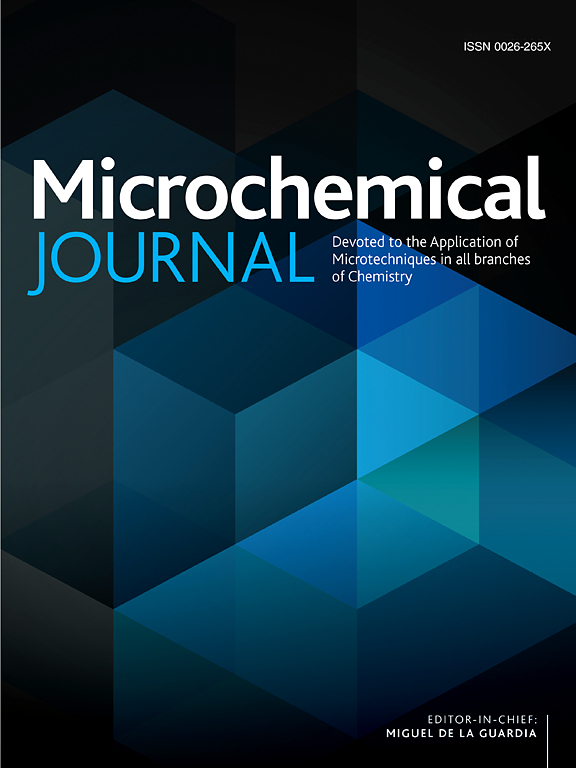采用QuEChERS高效液相色谱-质谱法研究了吡咯苯脲在水田中的残留分析方法及耗散动力学
IF 4.9
2区 化学
Q1 CHEMISTRY, ANALYTICAL
引用次数: 0
摘要
吡咯苯脲是一种新开发的杀螺剂,用于管理管状pomacea,但其环境行为仍未被探索。本研究建立并验证了一种高效液相色谱-质谱结合优化的QuEChERS预处理的残留检测方法,用于分析稻田环境中吡虫唑的耗散动态和最终残留水平。该方法在0.005 ~ 5 mg/L范围内线性良好(R2≥0.99)。检测限和定量限分别为0.00052 ~ 0.00294 mg/kg和0.00132 ~ 0.00945 mg/kg。日内、日间回收率为71.76% ~ 95.19%,RSDr值为0.83% ~ 5.42%,RSDr值为1.04% ~ 5.10%,验证了方法的精密度和可靠性。吡虫腈在水稻水、水稻植株和水稻土中的耗散动力学符合一级模型,在土壤中的半衰期(t0.5)为12.98 ~ 15.97 d,在水稻植株中的半衰期(t0.5)为11.00 ~ 12.20 d,表明其降解迅速。最终残留分析显示,在收获时,残留主要集中在水稻植株内,而糙米中的含量仍低于定量限值。本文章由计算机程序翻译,如有差异,请以英文原文为准。
Residue analysis method and dissipation dynamics of pyriclobenzuron in paddy fields studied by HPLC-MS using the QuEChERS method
Pyriclobenzuron is a newly developed molluscicide designed to manage pomacea canaliculata, yet its environmental behavior remains unexplored. This study developed and validated a residue detection method using HPLC-MS in conjunction with an optimized QuEChERS pre-treatment, enabling the analysis of pyriclobenzuron dissipation dynamics and final residue levels in a rice field environment. The method demonstrates excellent linearity (R2 ≥ 0.99) over the concentration range of 0.005–5 mg/L. Limits of detection (LOD) and quantification (LOQ) were determined to be 0.00052–0.00294 mg/kg and 0.00132–0.00945 mg/kg, respectively. Intraday and inter-day recovery rates ranged from 71.76 % to 95.19 %, with RSDr values between 0.83 % and 5.42 % and RSDR values from 1.04 % to 5.10 %, confirming the method’s precision and reliability. The dissipation kinetics of pyriclobenzuron in paddy water, rice plants, and paddy soil followed a first-order model, with half-lives (t0.5) of 12.98–15.97 days in soil and 11.00–12.20 days in rice plants, indicating rapid degradation. Final residue analysis revealed that, at harvest, residues were primarily concentrated within the rice plants, while levels in brown rice remained below the quantification limit.
求助全文
通过发布文献求助,成功后即可免费获取论文全文。
去求助
来源期刊

Microchemical Journal
化学-分析化学
CiteScore
8.70
自引率
8.30%
发文量
1131
审稿时长
1.9 months
期刊介绍:
The Microchemical Journal is a peer reviewed journal devoted to all aspects and phases of analytical chemistry and chemical analysis. The Microchemical Journal publishes articles which are at the forefront of modern analytical chemistry and cover innovations in the techniques to the finest possible limits. This includes fundamental aspects, instrumentation, new developments, innovative and novel methods and applications including environmental and clinical field.
Traditional classical analytical methods such as spectrophotometry and titrimetry as well as established instrumentation methods such as flame and graphite furnace atomic absorption spectrometry, gas chromatography, and modified glassy or carbon electrode electrochemical methods will be considered, provided they show significant improvements and novelty compared to the established methods.
 求助内容:
求助内容: 应助结果提醒方式:
应助结果提醒方式:


